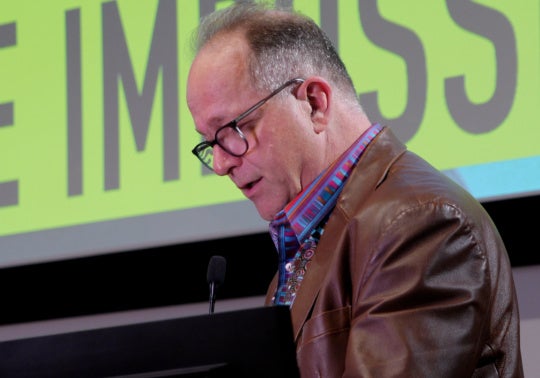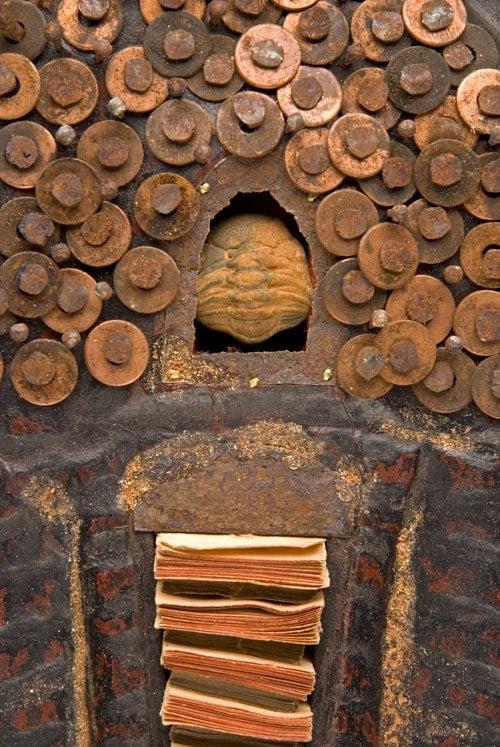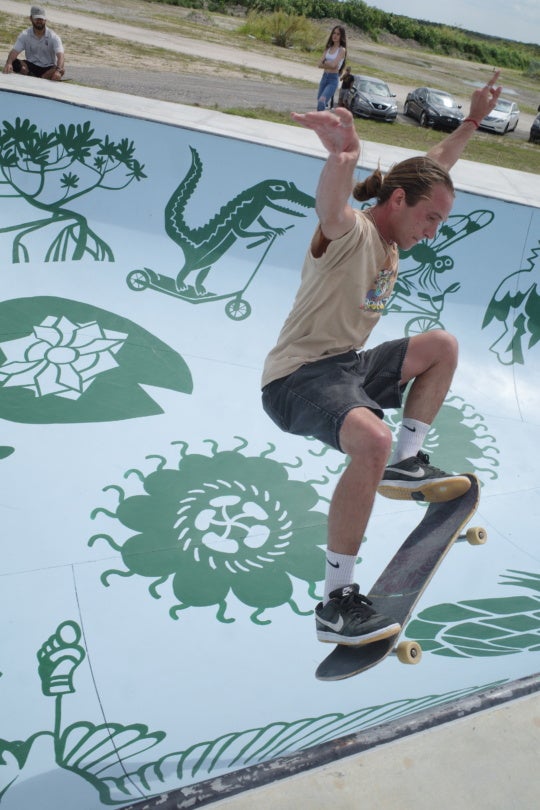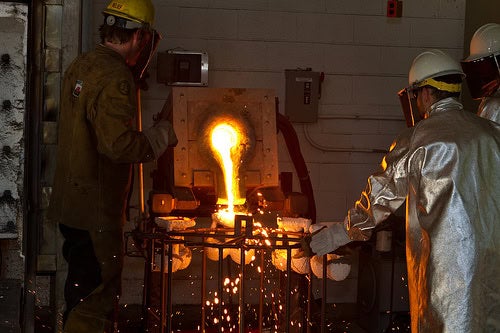
Martha Whittington creates moulds that not only define the shape of an object, but direct the flow of molten stainless steel that is poured in at an impressive 2900 degrees Fahrenheit. Each mould is used exactly once, and the molten object that comes out of each one, Whittington polishes so that the solidified steel has a smooth surface. 15 amazed visitors from MOCA GA’s ArtMERGE series watched as Allen Peterson, Professor of Sculpture at SCAD Atlanta, directed the pour into Whittington’s moulds, which are designed to create two halves of a single orb. Whittington will later weld the two halves together, and then spend another 8 hours polishing the orb’s surface. This process will be repeated for each orb—the collection of which she will showcase in her future exhibit at MOCA GA in 2012.
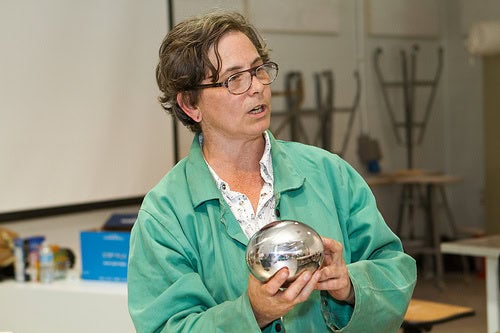
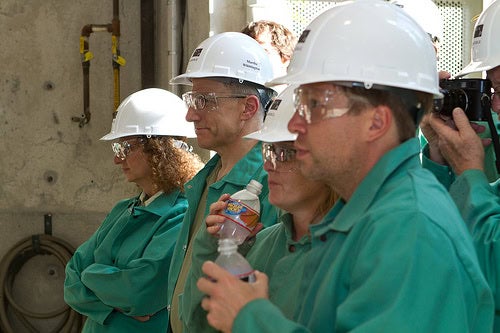
As a MOCA GA member, I paid $5 (an art bargain for certain) for the privilege of visiting the sculpture studio of SCAD Atlanta, located underneath the Woodruff Arts Center in Midtown. MOCA’s Martha Brewer shepherded her mostly older flock into an area where we donned hard hats, goggles, and a protective coat. Clearly, this was not going to be an ordinary studio visit. Whittington led us on a tour of both the wood and metal work areas to see the vast array of heavy duty tools available to students. One of my fellow visitors referred to them as looking like “machines of war”.
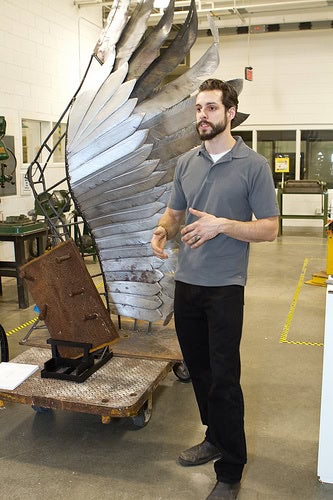
All of this was prelude to the main act of seeing molten steel, but first we were introduced to an emotional project currently in the works at the studio. Dekalb County Firefighter Doug Harms had an idea to create a 9/11 memorial for Dekalb County; and together with SCAD Alumnus Curtis James (C.J.) Miller they designed one that is currently under construction. The design incorporates themes of the Phoenix and the eternal flame. The concrete portions are to be constructed on the memorial site, but the metal sculpture is being created here at the studio by Miller and assistant Richard Corbett, a rising SCAD sophomore. Harms and two buddies drove to New York City to retrieve a piece of steel that was a part of the World Trade Center to be a part of the memorial. Many of my fellow visitors stared at it in varying degrees of awe and reflection. Professor Peterson told me that Miller started this project while still getting ready for his senior show. Following the show’s success, Miller now has a semester to work in the SCAD facility. “He is setting off his career with a bang.” People wishing to support the project may do so here.
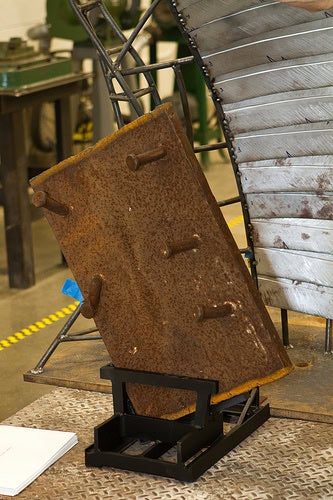
Outside of the studio and a few feet from the street, we gathered to watch the highlight of the evening: Peterson and his assistants pulled a rack of moulds out of a white-hot oven, and quickly and efficiently poured molten stainless steel into each mould. An assistant showed us a temperature sensor reading a toasty 2821 degrees. Each mould was carefully removed from the rack and set to cool on the ground, later to be placed in a bucket of water that instantly bubbled. While a few sparks flew at the end of each pour, none came close to us. What was missing from this demonstration was billowing smoke and shooting flames. It was all eerily tame looking if one discounted the protective clothing worn by the artists conducting the pour. Peterson said that was because they have a combustion furnace, a rarity in academic facilities. “There is nothing to affect people walking by.” The excellence of the equipment and professors has allowed this program to grow from the 8 students it started with in 2006 to the approximately 40 it has now. Despite the high heat, no student has ever been seriously burned due to the studio’s focus on safety.
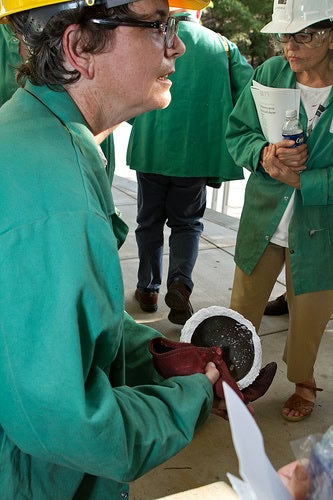
Whittington, both an educator here and a sculptor, next led us to a room to show us her moulds and other tools of the trade. Whittington created some of her tools herself. She was clearly at home handling our questions while showing us the moulds and a finished, polished orb. The orb was smooth, seamless, and quite heavy. Whittington’s statement “I spent 8 hours polishing it” sounded extreme at first, but while holding it I could see no evidence that it was once in two halves.
The evening concluded with some much needed water, fruit, and munchies. Whittington and Peterson mingled and talked with the MOCA GA visitors. Everyone I asked said they really enjoyed the experience. Whittington is one of three local artists being supported this year by the MOCA GA Working Artist Project (WAP). Each artist is supported with a financial stipend, a paid student assistant, and a solo exhibition. The next ArtMERGE event will visit Brian Dettmer’s studio on August 7 . Overall, this studio visit was an insightful and engaging experience; I highly recommend taking part in MOCA’s ArtMERGE as a unique way to learn about local artists, beyond the exhibit.

